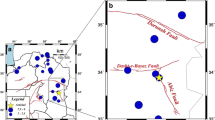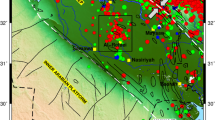Abstract
Estimating the macroseismic parameters of earthquakes such as location, magnitude, and fault orientation can be helpful to complete the earthquake catalogs, especially on historical ones or the ones whose parameters were estimated with low accuracy. This study aims to estimate the macroseismic parameters of Tabas earthquake (1978.09.16) using its reported descriptions, Macroseismic Data Points (MDPs). MDPs include any descriptions of earthquake effects on building damages and environmental effects of each location affected by the earthquake. Macroseismic dataset of Tabas earthquake is collected from different documents. Thus, this dataset is used to estimate the macroseismic parameters of this earthquake: macroseismic location, magnitude, intensity, and source parameters. Results estimate the macroseismic epicenter of this earthquake at 33.49°N–56.94°E with the moment magnitude, Mw, 7.1 and the maximum macroseismic intensity value XI in both EMS and ESI intensity scales. Its estimated source orientation is consistent to Tabas fault system in the direction NNW-SSE with the strike, length, and width value of the source in 166.8°, 55.8 ± 7.5 km, and 18.2 ± 1.4 km, respectively. Moreover, for future studies, the locations near Khosro Abad, close to the macroseismic epicenter of this earthquake, are suggested for the next field studies, sampling the sediments related to the past evidences and dating them.








Similar content being viewed by others
Data availability
Datasets related to this article were extracted from various documents, papers, and reports published by different centers and researchers. Centers and webpages such as International Institute of Earthquake Engineering and Seismology (IIEES) (http://www.iiees.ac.ir/fa/eqreports/), Statistical Centre of Iran (http://amar.org.ir/), EHB bulletin of Engdahl (http://www.isc.ac.uk/ehbbulletin/), Global CMT catalog (http://www.globalcmt.org/CMTsearch.html), and National Earthquake Information Center (NEIC) (http://earthquake.usgs.gov/contactus/golden/neic.php). Papers and documents such as Berberian (1982, 1979a, b), Sharp and Orsini (1978), Akasheh and Eshghi (1980), Niazi and Kanamori (1981), Walker et al. (2003, 2013), Statistical Centre of Iran (2006), Papeli Yazdi (1989), and Mofakham Payan (1960).
References
Ambraseys NN (2001) Reassessment of earthquakes, 1900–1-, in the Eastern, Mediterranean and the Middle East. Geophys J Int 145:471–485
Ambraseys NN, Melville CP (1982) A history of Persian Earthquake. Cambridge University Press
Amini H, Zare M (2016) Relationships between different earthquake intensity scales in Iran. J Seismol Earthq Eng 18(1):59–69
Amini H, Zare M, Ansari A (2018) Fault parameters and macroseismic observations of the May 10, 1997 Ardekul-Ghaen earthquake. J Seismol 22(1):5–19. https://doi.org/10.1007/s10950-017-9689-6
Amini H, Zare M, Gasperini P (2017a) Re-assessing the intensity values of Iranian earthquakes using EMS and ESI scales. Arab J Geosci 10:504. https://doi.org/10.1007/s12517-017-3226-3
Amini H, Gasperini P, Zare M, Vannucci G (2017b) Estimating the macroseismic parameters of earthquakes in Eastern Iran. J Geodyn 110:43–58. https://doi.org/10.1016/j.jog.2017.07.005
Amini H, Michetti AM, Fattahi M (2019) Environmental effects accompanying the Mw 7.3, November 12, 2017, Sarpol-e-Zahab earthquake: observations from the Iran border and preliminary ESI 2007 intensity. In: 20th INQUA Congress 25- 31 July 2019, Ireland, Dublin
Akasheh B, Eshghi I (1980) The Tabas (Iran) earthquake of 16 September 1978. Pure Appl Geophys 119:207–211
Berberian M (1979a) Earthquake faulting and bedding thrust associated with the Tabas-e-Golshan (Iran) earthquake September 16. Bull Seismol Soc Am 69(6):1861–1887
Berberian M (1979b) Tabas-e-Golshan (Iran) catastrophic earthquake of 16 September 1978; a preliminary field report, Pergamon Press Ltd. Disasters 2(4):207–219
Berberian M (1982) Aftershock tectonics of the 1978 Tabas-e-Golshan (Iran) earthquake sequence: a documented active ‘thin- and thick-skinned tectonic’ case. Geophys J R astr SOC 68:499–530
Berberian M, Asudeh I, Bilham RG, Scholz CH, Soufleris C (1979) Mechanism of the main shock and the aftershock study of the Tabas-e-Golshan (Iran) earthquake of September 16, 1978; a preliminary report. Bull Seismol Soc Am 69(6):1851–1859
Copley A (2014) Postseismic afterslip 30 years after the 1978 Tabas-e-Golshan (Iran) earthquake: observations and implications for the geological evolution of thrust belts. Geophys J Int 197:665–679. https://doi.org/10.1093/gji/ggu023
Efron B, Tbishirani RJ (1986) Bootstrap methods for standard errors, confidence intervals and other measures of statistical accuracy. Stat Sci 1:54–77
Fattahi M, Nazari H, Bateman MD, Meyer B, Se´brier M, Talebian M, Le Dortz K, Foroutan M, Ahmadi Givi F, Ghorashi M (2010) Refining the OSL age of the last earthquake on the Dheshir fault, Central Iran. Quat Geochronol 5:286–292
Gasperini P, Ferrari G (2000) Deriving numerical estimates from descriptive information: the computation of earthquake parameters. Ann Geofis 43:729–746
Gasperini P, Bernardini F, Valensise G, Boschi E (1999) Defining seismogenic sources from historical earthquake felt reports. Bull Seismol Soc Am 89(1):94–110
Gasperini P, Vannucci G, Tripone D, Boschi E (2010) The location and sizing of historical earthquakes using the attenuation of macroseismic intensity with distance. Bull Seismol Soc Am 100(5A):2035–2066
Grünthal G (ed) (1992) European Macroseismic Scale 1992 (up-dated MSK-scale). In: Cahiers du Centre Européen de Géodynamique et de Séismologie. Conseil de l’Europe, Conseil de l’Europe
Grünthal G (ed) (1998) European Macroseismic Scale 1998 (Cahiers du Centre Europèen de Gèodynamique et de Seismologie), Luxembourg
Guerrieri L, Michetti AM, Reicherter K, Serva L, Silva PG, Audemard F, Azuma T, Baiocco F, Baize S, Blumetti AM, Brustia E, Clague J, Comerci V, Esposito E, Gurpinar A, Grutzner C, Jin K, Kim YS, Kopsachilis V et al (2015) Earthquake environmental effect for seismic hazard assessment: the ESI-07 intensity scale and the EEE Catalogue. In: Memorie descrittive della Carta Geologica d’Italia, V. XCVII, pp 11–20
Hall P (1992) The bootstrap and edgeworth expansion. Springer, New York, p 372
Hessami K, Jamali F, Tabassi H (2003) Major active faults of Iran. Seismotectonic Department, Seismology Research Center
Niazi M, Kanamori H (1981) Source parameters of 1978 Tabas and 1979 Qainat, Iran, earthquakes from long-period surface waves. Bull Seismol Soc Am 71:1201–1213
Michetti AM, Esposito E, Gurpinar A, Mohammadioun B, Mohammadioun J, Porfido S, Rogozhin E, Serva L, Tatevossian R, Vittori E, Audemard F, Comerci V, Marco S, MaCalpin J, Morner NA (2004) The INQUA Scale, An innovative approach for assessing earthquake intensities based on seismically-induced ground effects in natural environment. In: Vittori E, Comerci V (ed) Memorie Descrittive della Carta Geologicad’ Italia, APAT, Roma, LXVII-116 Memorie
Michetti AM, Esposito E, Guerrieri L, Porfido S, Serva L, Tatevossian R, Vittori E, Audemard F, Azuma T, Clague J, Comerci V, Gurpinar A, McCalpin J, Mohammadioun B, Mörner NA, Ota Y, Roghozin E (2007) Intensity scale ESI 2007. In: Guerrieri L, Vittori E (eds) Memorie Descrittive della Carta Geologica d’Italia, Special, vol 74. APAT, Rome, pp 7–54
Mofakham Payan LA (1960) Gazetteer of Iran Villages. AmirKabir Publication
Nowroozi AA, Mohajer Ashjaie A, Peyman M, Taghizadeh GhA (1978) Aftershocks, spreading damages and field report on Tabas earthquake in eastern Iran (in Persian)
Papeli Yazdi MH (1989) Gazetteer of villages and religious places of Iran. Geography Department, The Islamic research foundation Astan Quds Razavi Iran
Sharp R, Orsini N (1978) Preliminary report on the Tabas, Iran, earthquake of September 16. U.S, Geology Survey
Sibol MS, Bollinger GA, Birch JB (1987) Estimations of magnitudes in central and eastern North America using Intensity and Felt Area. Bull Seismol Soc Am 77:1635–1654
Silva PG, Michetti AM, Guerrieri L (2015) Intensity Scale ESI 2007 for assessing earthquake intensities. In: Encyclopedia of Earthquake Engineering. https://doi.org/10.1007/978-3-642-36197-5_31-1
Walker R, Jackson J, Baker C (2003) Surface expression of thrust faulting in eastern Iran: source parameters and surface deformation of the 1978 Tabas and 1968 Ferdows earthquake sequences. Geophys J Int 152:749–765
Walker RT, Khatib MM, Bahroudi A, Rodés A, Schnabel C, Fattahi M, Talebian M, Bergman E (2013) Co-seismic, geomorphic, and geologic fold growth associated with the 1978 Tabas-e-Golshan earthquake fault in eastern Iran. Geomorphology. https://doi.org/10.1016/j.geomorph.2013.02.016
Wells DL, Coppersmith KJ (1994) New empirical relationships among magnitude, rapture length, rupture width, rupture area, and surface displacement. Bull Seismol Soc Am 84:974–1002
Acknowledgements
I would like to thank Dr. Morteza Fattahi and two journal reviewers for their careful reading of the manuscript and constructive comments to improve it.
Author information
Authors and Affiliations
Contributions
Writing—original draft, investigation, and preparing what is needed such as figures, maps, and tables were done by H. Amini. Author agrees to the published version of the manuscript.
Corresponding author
Ethics declarations
Competing interests
The author declares no competing interests.
Additional information
Publisher’s note
Springer Nature remains neutral with regard to jurisdictional claims in published maps and institutional affiliations.
Rights and permissions
Springer Nature or its licensor (e.g. a society or other partner) holds exclusive rights to this article under a publishing agreement with the author(s) or other rightsholder(s); author self-archiving of the accepted manuscript version of this article is solely governed by the terms of such publishing agreement and applicable law.
About this article
Cite this article
Amini, H. Fault parameters of the Tabas-e-Golshan earthquake, September 16, 1978 (eastern Iran), based on macroseismic observations, with locations for dating to improve the dataset. J Seismol 27, 707–718 (2023). https://doi.org/10.1007/s10950-023-10159-3
Received:
Accepted:
Published:
Issue Date:
DOI: https://doi.org/10.1007/s10950-023-10159-3




